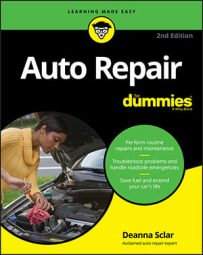Taking care of little dents and dings on a vehicle is a simple matter. This type of damage may not require much work at all, even on a car's aluminum and plastic parts. Here are some situations that you may want to tackle:
-
If the paint has simply flaked or has been scratched off the surface: Touch up the paint.
Before you prime and paint the vehicle, take care of any rust, dings, or dents that you find. By taking care of all these things at once, you can then put a final coat of paint on all of them at the same time and have a car that looks wonderful.
-
If a steel surface has been pushed in and hasn’t been badly creased: You can try to pop it back into place with a rubber plunger (the kind they call a plumber’s helper). Just moisten the edge of the rubber, place the plunger over the dent, establish suction by pressing down on the handle, and then pull it toward you. It may take a couple of tries before the metal pops back to normal. This technique works especially well on large expanses of metal, such as doors and fenders, if they have only been bent inward. It may work on aluminum as well as steel, depending on the size of the dent, but it doesn’t work on plastic body parts.
-
If you have small dents in a steel part: You can attempt to hammer them out by placing a flat piece of metal (with a rag wrapped around it to protect the paint from scratching) on the outer side of the vehicle and banging the dent from the underside with a flat-ended hammer. Be very careful to bang only the underside of the dent and not the surrounding area, or you’ll end up with a couple of new bumps to deal with. Work from the shallow sides of the dent toward the deeper areas and avoid overworking the metal, which stretches it.
Don’t try this with aluminum, which can stretch, or plastic, which is likely to crack.
-
If you have very small dings or places where the paint has chipped: You can fill them in with glazing putty, which is very easy to handle. Use a putty knife to apply it, following the directions on the package, and then prime and paint the area. If the damaged area is larger than a very small, shallow ding, you need to resort to a body filler designed specifically for a steel, aluminum, or plastic body.
There are inexpensive specialty shops that just fix dents and dings. Many of these “paintless” dent-repair specialists are mobile and will come to you. Always get an estimate before you commit to doing any bodywork yourself. Having the work done professionally may cost you so much less in time and effort than struggling through a learning process that it will be cheaper in the long run!

